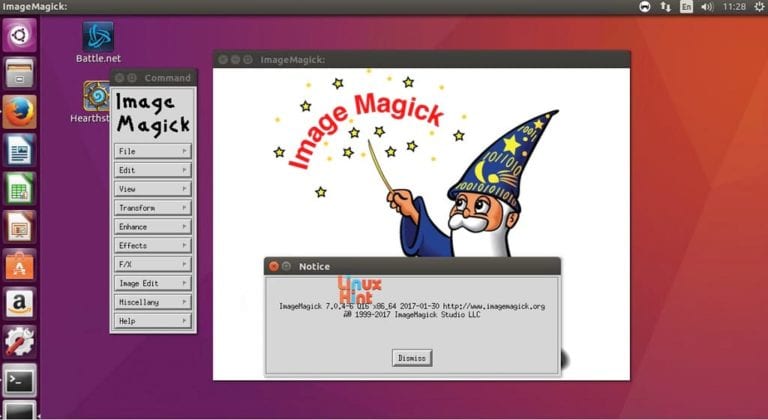

- #Ubuntu install imagemagick how to
- #Ubuntu install imagemagick update
- #Ubuntu install imagemagick full
- #Ubuntu install imagemagick software
ImageMagick is available in the default repositories of most Linux distributions. These latter features may be used to override decisions made by apt-get's conflict resolution system. ImageMagick has a command line tool named 'Identify' to find image metadata. Similarly a plus sign can be used to designate a package to install. Tip: The official html documentation is available locally when the packages are installed. Install from Source Install from Linux Source Install from Windows Source Chances are, ImageMagick is already installed on your computer if you are using some flavor of Linux, and its likely not installed if you are using some form of Windows. See ImageMagick(1), or gm(1) for GraphicsMagick. If a hyphen is appended to the package name (with no intervening space), the identified package will be removed if it is installed. Alternatively install graphicsmagick for GraphicsMagick, a fork of ImageMagick, emphasizing stability of the API and command-line interface. The /etc/apt/sources.list file is used to locate the desired packages. All packages required by the package(s) specified for installation will also be retrieved and installed. Each package is a package name, not a fully qualified filename.
#Ubuntu install imagemagick software
APT simplifies the process of managing software on Unix-like computer systems by automating the retrieval, configuration and installation of software packages, either from precompiled files or by compiling source code.Īpt-get is the command-line tool for handling packages, and may be considered the user's "back-end" to other tools using the APT library.Īpt-get install is followed by one or more packages desired for installation or upgrading. To remove ImageMagick package $ sudo dpkg -r imagemagick-6.8.More information about install using apt-getĪdvanced Package Tool, or APT, is a free software user interface that works with core libraries to handle the installation and removal of software on Debian, Ubuntu and other Linux distributions.
#Ubuntu install imagemagick full
You can find the full list of Imagemagick command line options from Why use *checkinstall* instead of *make install* ? Checkinstall will allow for easy ImageMagick packages later on. Instead of using *make install* command, we are going to to use *checkinstall* command. Now, you can use ImageMagick to create, edit, compose or convert digital images.
#Ubuntu install imagemagick how to
configure -helpįinally now we are going to install ImageMagick 6.8 on Linux Mint and Ubuntu. I have shown you how to install ImageMagick 7 on Ubuntu 20.04. To show available options to install for ImageMagick $. Thus installation is straightforward with yum command. ImageMagick is also part of standard Red Hat-based systems. sudo apt-get install imagemagick Install ImageMagick on Fedora, CentOS or RHEL.

ImageMagick is included in a base repository of Debian-based systems. Installing ImageMagick & Ghostscript on Ubuntu Raw howto.md You have Ghostscript installed, right Otherwise sudo apt-get install ghostscript This is important and installs the headers ( iapi.
#Ubuntu install imagemagick update
Now change your working directory to ImageMagick-6.8.7-5 directory $ cd ImageMagick-6.8.7-5 Install ImageMagick on Debian, Ubuntu or Linux Mint. Update Ubuntu system Before installing ImageMagick, update the apt index. Untar or uncompressed the ImageMagick file you downloaded $ tar -xzvf ImageMagick-6.8. The newest version of ImageMagick is 6.8.7-5 as of the time I’m writing this article $ wget $ sudo apt-get install build-essential checkinstall libx11-dev libxext-dev zlib1g-dev libpng12-dev libjpeg-dev libfreetype6-dev libxml2-dev You can download ImageMagick source code from imagemagick official websiteįirst you need to install all the build dependencies and other tools to install ImageMagick $ sudo apt-get update In this article I’m going to show you how to install ImageMagick 6.8 on Linux Mint and Ubuntu With ImageMagick, you can add effects, resize, crop, color change, roate, add text, line, as much as you can think of what to do what that image. Through standard Ubuntu repository - v6.9.11. ImageMagick supports over a hundred of image formats, some popular format like jpeg, png, pdf, svg, tiff and alot more. What is ImageMagick? ImageMagick is a linux program that let you create, edit, display or convert bitmap image on linux workstation or server.


 0 kommentar(er)
0 kommentar(er)
